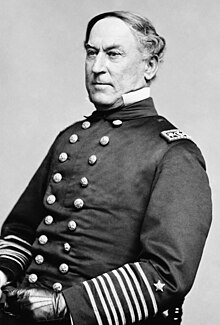
Back David Farragut Afrikaans David Farragut AN ديفيد فاراغوت Arabic Дейвид Фарагът Bulgarian David Farragut Breton David Farragut Catalan David Farragut Corsican David Farragut Czech David Farragut Welsh David G. Farragut Danish
David Farragut | |
|---|---|
 Farragut as a rear admiral, c. 1862–1864 | |
| Birth name | James Glasgow Farragut |
| Born | July 5, 1801 near Farragut, Tennessee, U.S. (at Lowe's Ferry) |
| Died | August 14, 1870 (aged 69) Kittery, Maine, U.S. |
| Buried | Woodlawn Cemetery, the Bronx |
| Allegiance | |
| Service | |
| Years of service | 1810–1870 |
| Rank | Admiral |
| Commands | USS Ferret USS Saratoga USS Brooklyn Mare Island Navy Yard European Squadron West Gulf Blockading Squadron |
| Battles / wars | |
| Signature | |
David Glasgow Farragut (/ˈfærəɡət/; also spelled Glascoe;[1][2][3][4] July 5, 1801 – August 14, 1870) was a flag officer of the United States Navy during the American Civil War. He was the first rear admiral, vice admiral, and admiral in the United States Navy.[5][6] He is remembered in U.S. Navy tradition for his bold order at the Battle of Mobile Bay, usually abbreviated to "Damn the torpedoes ... full speed ahead."[7][8]
Born near Knoxville, Tennessee, Farragut was fostered by naval officer David Porter after the death of his mother. When he was 11 years old, Farragut served in the War of 1812 under the command of his adoptive father. He received his first command in 1823, at the age of 22, and went on to participate in anti-piracy operations in the Caribbean Sea. He then served in the Mexican–American War under the command of Matthew C. Perry, participating in the blockade of Tuxpan. After the war, he oversaw the construction of the Mare Island Navy Yard (now Mare Island Naval Shipyard), which was the first U.S. Navy base established on the Pacific Ocean.
Though Farragut resided in Norfolk, Virginia, prior to the Civil War, he was a Southern Unionist who strongly opposed Southern secession and remained loyal to the Union after the outbreak of the Civil War. Despite some doubts about Farragut's loyalty, Farragut was assigned command of an attack on the important Confederate port city of New Orleans. After defeating the Confederates at the Battle of Forts Jackson and St. Philip, Farragut captured New Orleans in April 1862. He was promoted to rear admiral after the battle and helped extend Union control up along the Mississippi River, participating in the siege of Port Hudson. With the Union in control of the Mississippi, Farragut led a successful attack on Mobile Bay, home to the last major Confederate port on the Gulf of Mexico. Farragut was promoted to admiral following the end of the Civil War and remained on active duty until his death in 1870.
- ^ Dabney McCabe (1876) The Centennial Book of American Biography, P. W. Ziegler & Company, Philadelphia
- ^ Joel Tyler Headley (1867) Farragut, and Our Naval Commanders, E.B. Treat & Co., New York
- ^ Samuel Fallows et al. (1900) Splendid Deeds of American Heroes on Sea and Land, J. L. Nichols & Co.
- ^ P.T. Barnum et al. (1890) Dollars and Sense, or, How to Get On, People's Publishing Company, Chicago
- ^ Farragut, 1879, p. 3
- ^ Hickman, 2010, p. 216
- ^ Stein, 2005, p. 5
- ^ Spears, 1905, p. 328